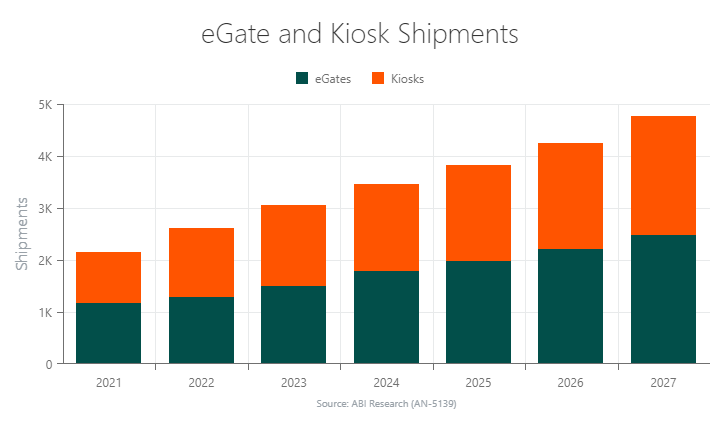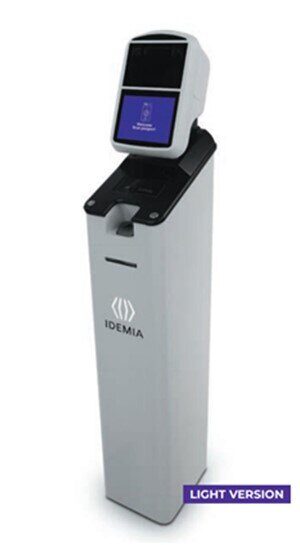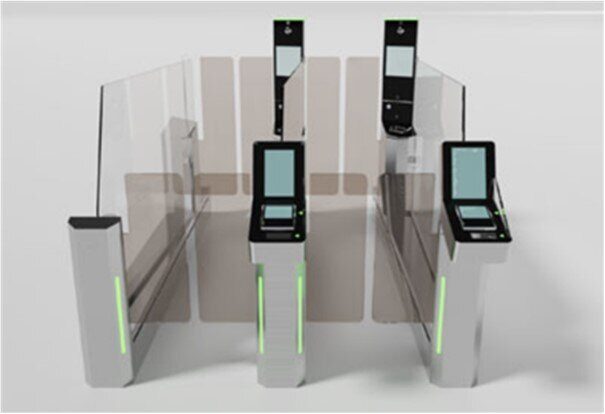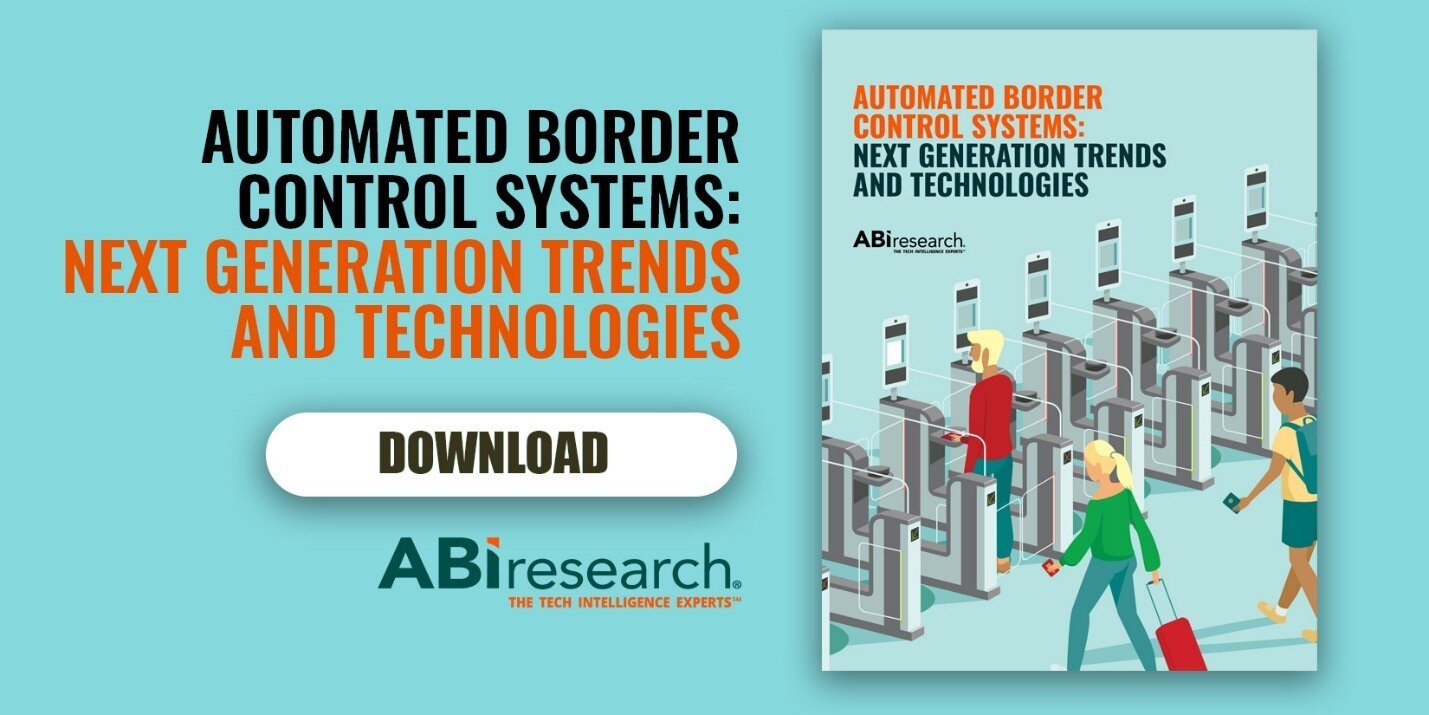After the September 11th terrorist attacks on the United States in 2001, the world changed in many ways, with perhaps the most profound effects happening in border security (airports, seaports, etc.) and law enforcement. Biometric-based identity emerged as a critical solution, but governments and security agencies experienced several challenges over the years. Fast forward to today, those challenges (e.g., data leaks, poor facial recognition accuracy, inconsistent algorithms, etc.) have mostly been resolved, making Automated Border Control (ABC) technologies ready for more extensive deployment. Electronic gates (eGates) are the pinnacle of this next generation of border security.
eGates are gaining an increasingly pivotal role in border protection as international travel bounces back, and ABI Research’s market forecasts highlight this trend. Growing at a Compound Annual Growth Rate (CAGR) of 13.9%, annual eGate shipments will increase from 1,166 units in 2021 to 2,473 units by 2027 (see the chart below). With a massive influx of citizens traveling to other countries, governments and border control agencies can quickly find themselves overwhelmed with identity verification. In today’s hyper-globalized world, automated technology, proven to be secure and efficient, is a must for governments, airports, seaports, law enforcement agencies, and other border control stakeholders. eGates fit that bill because they enable travelers to self-service their border crossing process using biometric identity verification.

Below is the video version of this blog post, pulled from the ABI Research YouTube channel.
What Is an eGate?
eGates are Automated Border Control (ABC) systems allowing citizens to self-service as they travel across country lines. Behind this automated form of border crossing are biometric data stored in the chip of a citizen’s ePassport. These biometric data are captured when a citizen enters the eGate to verify the passport holder’s identity (e.g., facial recognition). Biometric gates provide citizens with a secure and seamless travel experience with minimal staffing needs on the part of airports, seaports, and other transportation hubs.
How eGates Work
Biometric verification within a Border Control Management (BCM) system is done through capture from dedicated sensors within eGates. Typically, this is done with facial biometrics, but iris and fingerprint recognition are sometimes used. Manual assistance is only required if an ePassport holder’s identity cannot be verified or an error occurs. In that case, an immigration/port security officer overseeing a gate will meet the citizen and resolve the issue.
eGate functionality depends on three levels of control:
- Confirm that the presented travel document is genuine.
- Validate that the citizen is the legitimate ePassport holder (biometric validation)
- Verify that the passport holder actually has permission to enter the country.
Why Biometric eGates Are in Demand
The growing demand for biometric eGates is a result of three key motivations for border control stakeholders: enhanced border security, improved customer experience, and staffing optimization.
Enhanced Border Security
Fear is one of the greatest motivators in life, so it should be no surprise that the threat of terrorism is one of the top reasons why countries want biometric-based gates. More specifically, eGates help prevent terrorists from entering a country because of biometrics’ enhanced security. The effectiveness of biometrics in preventing the unlawful entry of terrorists has been known for a long time and was a big theme post-9/11. Between high-tier biometric readers in an ABC system and the tamper-proof secure elements in an ePassport, spoofing an identity is exceptionally challenging.
Illegal immigration is another reason for the increased demand for biometric eGates. With illegal border crossings at high levels—in both the European Union (EU) and the United States—border protection authorities need a better way to circumvent this activity, as well as human trafficking.
ABC vendors should pay close attention to how the upcoming European Entry/Exit System (EES) will change border security demands in Europe. The EES is an automated Information Technology (IT) system for registering non-European Union (EU) nationals traveling within Europe for a short stay (up to 90 days). With EES, citizens outside the Schengen Area must have their biometrics captured and stored in order to enter European countries. The consensus means of this capture is using a biometric kiosk, which enables speedy self-service. This shift to EES is giving rise to faster-growing demand for biometric-based kiosks when compared to eGates.
Figure 1: IDEMIA TravelKiosk (Source: IDEMIA)

Improved Customer Experience
The appetite for air travel is significant, with global airline traffic up 68.5% compared to pre-pandemic levels. BCM infrastructure must be resilient to surging travel demand, and eGates are integral to making that happen.
Biometric gates reduce flight delays, streamline processing time, and increase travelers’ clearing times. In a world where flight delays are at record levels, airports with automated processing capabilities are poised to find favor among travelers.
Moreover, a good ABC system is an important differentiator in attracting travelers. An improved traveler experience is listed as a key benefit of eGates by nearly every major stakeholder when announcing a new biometric border control application.
Further Insight
Automated Border Control Systems: Drivers, Demand Forecasts, Competition, and Vendor PrioritiesThe Effect of International Travel’s Rebound on Passport Issuance and Border Control Infrastructure
New European Entry/Exit System Rulings are Shifting Automated Border Control Requirements
Staffing Optimization
The automation that biometric eGates bring allows border control authorities to reduce their staffing needs. One staff member can manage several gates and only intervene when a traveler experiences an issue. Compared to having to manually check on each citizen at a traditional airport, an ABC system with an eGate is far more efficient for staffing. eGates are also beneficial because automation eradicates human error and is more reliable than human workers.
Biometric Technology Is Maturing, Which Enables Greater eGate Adoption
A key enabler in the widespread use of biometric-backed eGates is the growing penetration of ePassports, which store biometric data. This growth is occurring concurrently with a boom in post-pandemic international travel. ABI Research estimates that 87% of passports in circulation today are ePassports that use biometric identifiers.
Biometric technology has evolved past its nascent stage, and advancements in Machine Learning (ML)-based algorithms make biometric identification more accurate than ever. Similarly, facial recognition technologies have matured. In December 2022, the Transportation Security Administration (TSA) began using facial recognition technology at 16 airports across the United States. While some cities, such as San Francisco, outlaw facial recognition, others, such as Atlanta, Boston, and Detroit, are open to this technology for enhanced airport security.
Finally, biometric data sharing is more efficient than in the past, enabled by cross-government platforms. This makes it easier for border control authorities to detect someone on an international blacklist.
Types of eGates
Airports and other transport hubs have four different types of eGates to choose from for their automated BMC system: two-door gates, one-door gates, bidirectional gates, and family gates.
Two-Door eGates
Two-door eGates are the most popular variant of eGates, and ABI Research expects them to continue dominating the market. Companies like Thales, IDEMIA, Vision-Box, and Magnetic Access, already offer established two-door eGate solutions for automated border control.
With a two-door gate, the first step of the process is for the citizen to present their travel document to the optical reader of the system. Once the document is captured and verified, the first gate door opens, prompting the citizen to enter the holding area. The door behind them closes. This brings the advantage of clarity for the surveyor that a single citizen has been cleared of this first level of control. Additionally, the traveler is now held in the mantrap of the gate, being secure and convenient for airport operators if manual intervention is required. The citizen remains between the two doors and awaits instructions about the next steps.
Once clear of the first door, the biometric verification process begins, capturing the traveler’s biometrics and referencing that against biometric data within the ePassport. Upon successful matching, the final level of border protection will be evaluated, and grants access to the citizen once cleared.
Figure 2: Thales’ Two-Door Segregated eGate (Source: Thales)

One-Door eGates
One-door eGates operate more or less the same as two-door gates, but with a caveat. Having only one door means the border control system lacks a mantrap holding area like a two-door eGate. While a one-door gate may be more spatially efficient and comfortable for the traveler, it makes it more difficult to ensure a single traveler is passing through. As this challenge increases the chances of an illegal breach, more active monitoring is required by airports, seaports, or other border protection officials. Shipments for one-door eGates have increased in recent years, but that flaw will limit its market potential.
Bidirectional eGates
Bidirectional (two-way) eGates are automated border control systems used in both directions between border checkpoints. This type of eGate can most commonly be found in seaports.
Bidirectional eGates save space, as a single unit can be installed instead of two separate biometric gates. This form of eGate works best when travelers have to enter and exit a border in one day. Cruise ships are an excellent example of this use case. While most attention is paid to airports for eGates, seaports are a more niche, yet potentially significant market opportunity. Therefore, ABC vendors should hold maritime border security in high regard.
Family eGates
Family eGates allow multiple people to have their biometric identity verified at a border crossing simultaneously. This is very appealing to families with younger children who do want to be separated during the process. Even more, certain scenarios exist where children are not permitted to pass through an eGate unattended, prompting manual passport screening instead. The availability of a family gate would solve this problem and improve border control processes' speed and efficiency.
Family eGate solutions are still being developed, so active deployments do not exist yet. However, this type of eGate is expected to be a substantial market opportunity once available as airports aim for more streamlined traveler experiences.
Reflection on eGate Projects
Automated eGate projects abound across airports worldwide. A successful project, however, hinges upon several implementation factors:
- Secure network components to allow communication between different servers, platforms, and databases.
- Interoperable systems to alleviate conflicts and allow easy integration of all different hardware and software components.
- Top-of-the-line biometric processing with minimal algorithm bias, low False Accept Rates (FARs), and False Reject Rates (FRRs).
- Clearly outlined commercial benefits of implementing an ABC project, i.e., monetization schemes, partnerships, exploring new revenue streams, infrastructure upgrade requirements, and establishing stakeholder Return on Investment (ROI) goals.
- Device management platforms for all connected elements.
- Data security, encryption, and biometric data format conversion systems for the back end servers.
- Operational Technologies (OT)-related considerations, including processing latency, network connectivity, surge-resistant power supply, and other operational parameters, including maintenance.
eGate implementers also can’t forget about the importance of interoperability. Below are key ABC system and biometric standards to pay attention to for a more seamless eGate installation.
- Specifications for MRTDs: ICAO 9303
- Biometric data interchange formats: ISO/IEC 19794-5:2011 and ISO/IEC 19794-7:2014
- Traveler processes for biometric recognition in ABC systems: ISO/IEC TR 29195:2015
- Identification cards and biometrics: ISO 35.240.15
- Cards and security devices for personal identification: ISO/IEC 14443
- Identification of information systems as national security: NIST SP 800-59
- Specification for Web Service Biometric Devices (WS-BD): NIST SP 500-288
Learn more about the eGate market and key vendors by downloading ABI Research’s Automated Border Control Systems: Next-Generation Trends and Technologies report. This content is part of the company’s Citizen Digital Identity Research Service, which includes research, data, and ABI Insights.


